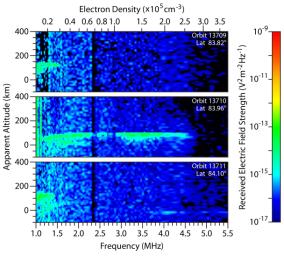Radar-Detected Change in Martian Near-Polar Ionosphere After Comet’s Flyby
Caption:
These three plots are spectrograms showing the intensity of radar echo in the Martian far-northern ionosphere at three different times on Oct. 19 and 20, 2014. The middle plot reveals effects attributed to dust from a comet that passed near Mars that day. The data are from the Mars Advanced Radar for Subsurface and Ionospheric Sounding (MARSIS), an instrument on the European Space Agency's Mars Express orbiter.
The horizontal axis is the radio-wave frequency of pulses emitted by MARSIS. The vertical axis is the altitude above the Martian surface, as estimated based on the time delay between transmitting the pulse and receiving its reflected signal. The apparent altitude has been computed with an assumption that the radar signal propagates at the speed of light, uncorrected for dispersion and other effects. Increasing intensity is indicated by color-coding from blue to red, as shown by the scale on the right.
All three spectrograms were collected as the orbiter passed overhead at about 84 degrees north latitude.
The top spectrogram shows conditions a few minutes before comet C/2013 A1 Siding Spring sped within about 87,000 miles (139,500 kilometers) of Mars. Except for a weak echo below 1.5 megahertz at about 93 miles (150 kilometers) altitude, no other echoes can be seen. This is typical of the night side of Mars, where little ionization is expected because of the absence of solar illumination.
The middle one, from about seven hours later, shows a new, temporary layer of enhanced electron density within the ionosphere. The layer was at an altitude of about 50 miles (80 kilometers), extending to about 4.6 megahertz, with an electron density of about 260,000 electrons per cubic centimeter. Densities this high have never previously been detected by Mars Express on the night side of Mars.
The bottom spectrogram, from another seven hours later, shows that the temporary layer had cleared away. Researchers attribute the temporary layer to heating caused by high-velocity entry into the Martian atmosphere by fine dust particles that were released by the comet.
Background Info:
NASA and the Italian Space Agency jointly funded MARSIS.
Cataloging Keywords:
| Name |
Value |
Additional Values |
| Target |
Mars |
C/2013 A1 (Siding Spring) |
| System |
|
|
| Target Type |
Planet |
Comet |
| Mission |
Mars Express (MEX) |
Mars Express |
| Instrument Host |
Mars Express |
Mars Express Orbiter |
| Host Type |
Orbiter |
|
| Instrument |
Mars Advanced Radar for Subsurface and Ionosphere Sounding (MARSIS) |
|
| Detector |
|
|
| Extra Keywords |
Atmosphere, Color, Dust, Radar, Radio |
| Acquisition Date |
|
| Release Date |
2014-11-07 |
| Date in Caption |
|
|
| Image Credit |
ASI/NASA/ESA/JPL/Univ. of Rome/Univ. of Iowa |
| Source |
photojournal.jpl.nasa.gov/catalog/PIA18859 |
| Identifier |
PIA18859 |

 Planetary Data System
Planetary Data System
